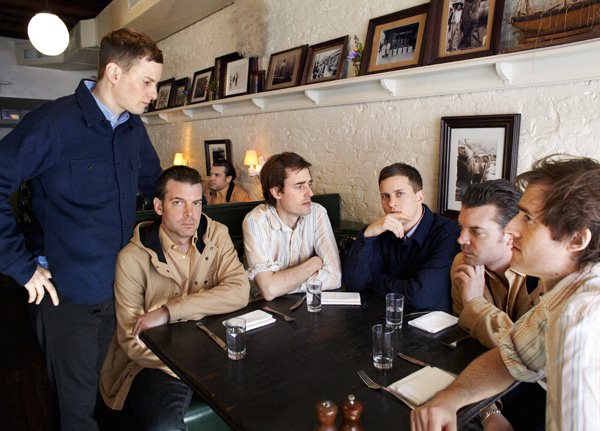This content appears in the July/August iPad edition of ALARM Magazine. Download it for free and keep reading!
 Battles: Dross Glop (Warp, 4/17/12)
Battles: Dross Glop (Warp, 4/17/12)
“Rolls Bayce (Hudson Mohawke Remix)”
If the appeal of a cover tune rests on an artist’s ability to emulate a preexisting song and bring new flavors to it at the same time, then the remix is something of an estranged relative. With remixes, the implicit goal is to stretch an existing piece of music as far as it can possibly go. Remixers are thus encouraged to let their musical personality eclipse the composer’s. They are essentially hired to take risks, to reconstitute, and to deconstruct — even altogether ignore — the mood, structure, and musical components with which they’ve been given to work.
The end results often qualify as works of art unto themselves, yet they also exist more or less as novelty items. Arguably, few remixes connect with more than a limited niche audience — even for fans of groups like Massive Attack and Depeche Mode — and the thought of a group of remixes working together within the larger framework of a full-length album remains an anomaly.
But that isn’t stopping experimental rock trio Battles from trying.
“Remixes can be tricky,” muses Battles guitarist/keyboardist Ian Williams. “A lot of them suck, so we’re going about making a remix record knowing that. In some ways, they’re cheap, but on the other hand, they can be good if you’re patient about the process.”
As a companion to last year’s Gloss Drop, the inversely titled Dross Glop consists entirely of Gloss Drop music reworked by the likes of Kode9, Shabazz Palaces, Gang Gang Dance, The Field, and Gui Boratto. Given the band’s unpredictable creative trajectory to this point, it’s no surprise that Williams and his bandmates, guitarist / bassist / art director Dave Konopka and drummer John Stanier, have released something to induce head-scratching among existing fans and electronica fans alike.
“Remixes can be tricky. A lot of them suck, so we’re going about making a remix record knowing that.”
Stacked with propulsive grooves, the highly rhythmic Gloss Drop surely would have made suitable fodder for breakbeats and a conventional dance-floor makeover. Indeed, the new album does contain some perversely appealing moments that illustrate what a “Battles in the club”-type culture clash would sound like. But Dross Glop wasn’t conceived as an overt stab at contemporary dance cred along the lines of U2’s Pop.
“We thought about it as something that would exist in the club and dance world,” Williams explains, “but we’re also going for something that’s weirder than that. There are so many different subcultures involved in this kind of thing. There’s the dance world, which can be really cheesy, but then there’s a cooler, more indie version of that. It’s a matter of ‘who are you making the music for?’”
It’s a rhetorical question, but the answer is, apparently, not any single audience. The band selected a crop of remixers who would bring disparate points of view to the table.
“I like juxtapositions,” Williams says. “The more wild and disjointed a connection is, sometimes I like that. I know in the world of dance music, there’s a sense of keeping the BPM flowing, but I like ruptures. My two bandmates tend to favor continuity. When you group things, you can have three blue things, three red things, and three green things, etc., but I tend to advocate for jumping from hot into cold.”
Prior to being assembled into a full-length running order, the remixes were grouped according to style as four separate 12-inch singles and slated for release on a staggered schedule leading up to Record Store Day 2012. (Writing for the next studio offering is scheduled to begin this year as well.) According to both Williams and Konopka, the band invested considerable time and thought into its plan to unveil the material in phases.
“The first 12-inch is a banger,” Konopka says. “It comes out of the gate pretty strong with some awesome techno stuff. The second one has more of a hip-hop-y vibe to it. The third one has more of a super-minimal Berlin-style techno thing going on, and then the last one is totally out-there stuff.”
“I think,” he continues, “that it makes it more interesting for a fan to do it that way. At least it does from my perspective. Back in the day, the idea of the EP was to leak out music and break it up a little bit. I love smaller doses of music, rather than making this one grand statement.”
Listeners who do intend to digest these remixes in one sitting should prepare to cover a broad range of musical terrain. But if Battles is known for its almost subversive ability to tap into a musical language that exists free of genre, Williams and Konopka aren’t taking any credit this time around. Certainly, the band helped curate the group of artists who took part, but Williams and Konopka stress that they had no direct input in the way that the various remixers went about their tasks — other than occasional back-and-forth dialogue — and that they were content to play the role of observers.

“With the guest vocalists on Gloss Drop,” Konopka recalls, “it was more like, ‘I like where you’re going with that. We’ll move the song around’ and ‘Can you try this?’ But with remixes, it is what it is. We wanted a scope of artists. In choosing the scope of the artists, you’re also blueprinting the scope of the album as well. But when it comes down to the actual remix itself, I don’t think it’s that important to shape somebody’s vision. It’s kind of not our place to do that. The fact that someone’s willing to participate and do a remix for you is flattering enough.”
As such, some of Dross Glop falls more closely within established boundaries than Battles fans may come to expect. Still, even in residual traces, the band’s oft-heralded oddness manages to shine through. More compellingly, some of the new interpretations bear no resemblance whatsoever to their original counterparts. Without a look at the track listing, listeners at times will be hard-pressed to match what they’re hearing with a specific tune from Gloss Drop.
In the hands of The Field (Axel Willner), for example, the playful bounce that defines “Sweetie & Shag” dissipates into an ominous, zero-gravity haze. Likewise, it’s hard to draw any discernable connection between the scurrying guitar and keyboard lines at the center of “Wall Street” and the melodramatic fashion-runway disco that Brazilian producer Gui Boratto presents in its name. Going in another direction entirely, Seattle hip-hop group Shabazz Palaces turns the driving, melancholic “White Electric” (along with its carnival-esque coda) into an acid-fried backdrop for a foul-mouthed rap. Though instantly recognizable, Williams’ organ phrases from the original now sound as if a rapping cult of gremlins from Funkadelic’s home planet raided the studio and had their way with the console in the middle of the night.
“Gloss Drop had a lot of sonic stuff going on,” Williams says, “so there were so many things for a remixer to focus on. Gloss Drop is sort of a maximal record, and you can do a minimal take on a maximal piece. It was interesting to see which little snapshots each remixer chose to focus on. A remixer might keep shooting until they grab the right thing to build the song around. One guy was having the hardest time; he couldn’t figure out how to do the remix. He finally latched onto the right minute piece of the song and built a whole new song out of that.”
It’s not inconceivable that the remixes could become source material too. If any of them were to get in the hands of adventurous DJs and turntablists, the original tracks would take on yet another life. So there’s no telling what their next stage of creative evolution might sound like. And evolution, after all, has been at the core of Battles — whether transitioning to the poppy, vocalized tracks of Mirrored or adapting to life as a trio following the departure of Tyondai Braxton. So, naturally, there’s no telling what the next Battles studio offering will sound like either.
“I can say,” Williams says, “that I’m interested in the idea of doing all analog for the next thing. For the last record, I played with three laptops all the time. I’m finding a pure analog sound-stream to be sexy. That would be very liberating for me in some ways.”
And how much should we expect to hear guest vocals next time?
“I don’t know,” Williams answers. “That remains to be seen.”
“I haven’t really given that too much thought,” Konopka concedes. “I like the ratio of vocals to instrumentals that we had on the past albums. I would be okay leaning either way; I just don’t want an album full of guest vocalists. We were really reluctant to go full-on instrumental after Ty left. I think we can exist in both worlds.”
For Battles, dual existence only seems fitting — much like a remix.

